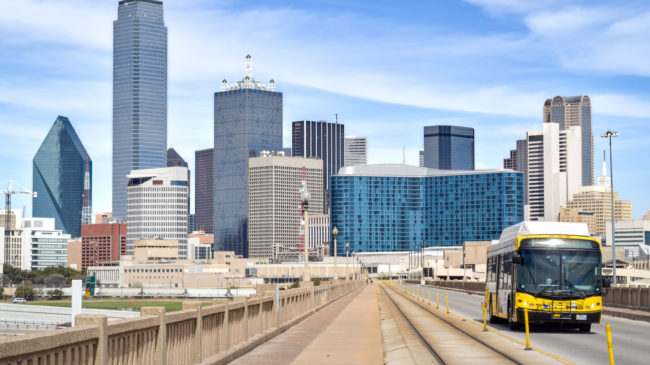On Wednesday, the House Transportation and Infrastructure Committee is scheduled to consider the proposed $495 billion surface transportation bill. The House bill, the INVEST in America Act, is being promoted by Transportation and Infrastructure Chairman Peter DeFazio (D, OR) as a fresh look at highways, transit, and intercity rail transportation, in an effort to make America “greener”—i.e., producing fewer greenhouse gases (GHGs) from transportation, which is currently the largest source of human-generated CO2 in the country.
While there are many small adjustments in the bill, such as new greenhouse gas standards that states must meet, a major thrust of the bill is to reallocate federal transportation spending. Highway funding would get a modest 28 percent increase over five years, mass transit would get 54 percent more, and intercity rail (aka Amtrak) would get what Eno Transportation Weekly’s Jeff Davis calls “a gobsmacking 332 percent increase,” with $12.5 billion on offer.
There are numerous questions about how these enormous increases would be paid for, and Davis recently estimated that if the bill were funded largely by gasoline and diesel user taxes, the federal gas tax of 18.4 cents per gallon would have to be doubled —which nobody thinks will happen, especially in an election year. So don’t be surprised if what ends up happening is invoking “Modern Monetary Theory” to simply borrow even more money that our grandchildren will have to pay back.
But what I want to question is the premise that shifting huge sums to mass transit and passenger rail would make America greener. There’s growing evidence that it would not. For example, cars are presumed to be more polluting (both conventional emissions and CO2) than mass transit—but that is no longer so. Decades of improvements in fuel efficiency, with fuel-sipping cars replacing gas guzzlers, have made today’s overall vehicle fleet much less polluting. In an April study for the Cato Institute, Randal O’Toole assembled data on energy use by cars, SUVs, and transit buses from 1970 through 2017. The Energy Department’s 2020 Transportation Energy Book shows that the average car in 2017 consumed 2,890 BTUs per passenger mile, compared with 4,535 for the average transit bus—just about the reverse of the situation in 1970.
O’Toole then converted this to CO2 per passenger mile and did this for each of the 100 largest urban areas. He found that for all but seven of the largest 100 urban areas, cars emit less CO2 per passenger-mile than transit buses. So pouring more taxpayer dollars into transit as a GHG-reduction measure would not make transportation greener.
What about intercity passenger rail versus other modes?
The Transportation Energy Book omits intercity buses, but you should not, since those buses serve five times as many destinations as Amtrak and handle about twice as many annual passengers. The most recent GHG comparison I can find is a 2008 study from the Union of Concerned Scientists, Getting There Greener: The Guide to Your Lower-Cost Vacation. It compares the carbon footprint of intercity buses, rail (Amtrak), cars, SUVs, and planes, for individuals and families of four. The greenest alternative, in every case, is the intercity bus. For example, on a single–person trip of 500 miles, the bus emits 85 pounds of CO2 per person compared with 215 pounds by Amtrak. For a family of four, it’s 335 pounds for the bus versus 860 pounds for Amtrak. Yes, as of 2008 cars and SUVs were worse than Amtrak, and so was flying (except for trips of 2,500 miles or more). Amtrak requires huge taxpayer subsidies, while intercity buses receive much smaller amounts of extra funds. Quadrupling tax money for Amtrak will not make America greener.
Well then, what about high-speed rail?
In contrast to Amtrak’s mostly diesel-powered trains, true high-speed rail (HSR) would be electric, with emissions lower than diesel trains. But that ignores the enormous energy and GHG impact of building HSR. University of California—Berkeley researchers Mikhail Chester and Arpad Horvath published a study on the life-cycle economic and environmental costs of the planned California HSR project from Los Angeles to San Francisco. Comparing autos, airplanes, and HSR, they estimated the environmental (GHG) return on investment from expanding north-south highway and airport capacity or building HSR. They concluded that building HSR was worse than the alternatives. It would take 71 years before the CO2 savings from operating the HSR trains offset the CO2 generated in building it. So much for HSR as a good green investment!
With the California high-speed rail project now estimated to cost over $80 billion, if it’s ever completed, the $12.5 billion in the House bill is obviously not going to build HSR. If appropriated, it will likely be poured into Amtrak.
House leaders may think the public can be swayed by their portraying billions in additional spending for transit and Amtrak as “green,” but the opposite is the case. If Congress really wanted to make transportation greener, it would provide more incentives for electric vehicles and encourage intercity buses to take Amtrak’s place on the vast majority of its diesel-powered routes.

